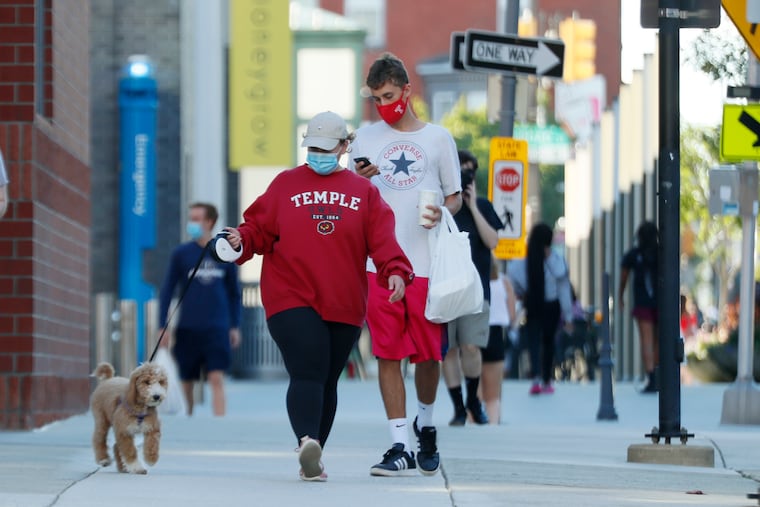Reopening schools and restarting the economy, done wrong, will be a disaster | Opinion
Here are lessons from behavioral science on how to get it right.

COVID-19 poses unprecedented challenges to a divided nation led by a president who said about our lack of COVID testing: “I don’t take responsibility at all.” Pennsylvania and Philadelphia, like states and communities nationwide, have agonized over whether to open schools given the trade-off between the health of students and teachers, and the educational and social benefits of in-person classes. Decisions about when and how to reopen workplaces are similarly difficult given the desire to restart the economy without endangering employees.
Due to the sometimes counterproductive manner in which people respond to risk prevention guidelines, social distancing, mask-wearing, and other recommended actions are being ignored, spreading the virus in ways that could have been avoided. As a result, many decisions to open schools and workplaces are now doomed to failure.
A large body of empirical research has identified many cognitive biases and behavioral obstacles that compromise decision-making in the face of risk. Policy must be informed by the challenges these behavioral problems pose. For example, the coronavirus spreads exponentially, but we typically base our judgments on straight-line projections of early small increases, vastly underestimating the magnitude of the looming crisis. To illustrate this point, by the end of February, only 70 people had tested positive for COVID-19 in the United States, and little attention was paid to the possibility of a pandemic. By March 31, the number of cases exploded to over 188,000, with states initiating shelter-in-place regulations and requiring businesses to close.
» READ MORE: There’s more to COVID safety than 6 feet of social distance. Here’s what else to consider.
Now with more than six million cases, there are precautions we must take to overcome recognized behavioral hurdles to containing the spread. Extensive testing is seen as an important tool to identify and contain COVID-19 infection. But because no test is perfect, there will be widespread misunderstanding by the general public and key decision-makers regarding the likelihood of false positive or false negative results, as behavioral studies have clearly demonstrated. In areas with low prevalence of the virus, positive test readings are likely to be wrong, resulting in unnecessary and costly consequences to individuals and the community. Therefore, it will be important to have independent second tests before imposing quarantines and contact tracing.
Despite their limitations in diagnosing individual cases, tests are valuable for tracking community infectivity and setting guidelines. Consider a community where only 1% of residents test positive for COVID-19. It may then be appropriate to open schools for classroom teaching since there is a very low chance of an outbreak. Once a community has made this decision, it will be important to test teachers, staff, and students at regular intervals.
Communities with high rates of infection must wear masks and social distance to reduce the spread of the virus. However, the health benefits of these actions are delayed and not visible, while the costs due to inconvenience and restricted freedoms are immediate and tangible. Lack of self-control and impulsive risk-taking among some young people further predicts that college students are unlikely to adhere to protective guidelines. As a result, without well-enforced regulations, adherence to these vital protective measures will erode over time. Holding accountable those who violate these essential requirements could help establish social norms and motivate recalcitrant residents to follow the rules.
» READ MORE: New Jersey Gov. Phil Murphy is reopening indoor dining. Restaurants are still worried.
The spread of COVID-19 on the campuses of a number of colleges and universities demonstrates these behavioral challenges and explains the chaos we face when we don’t take them into account when planning to reopen. Predictably, a growing number of universities that asserted earlier this summer that their faculty would teach in the classroom have now decided to close on-campus activities due to an increase of COVID-19 after students have arrived.
States and communities face similar behavioral challenges as they struggle to decide how to safely reopen bars, restaurants, factories, and other workplaces where individuals are in close quarters. The pressures to reopen are great. Following a presidential executive order toward the end of April, meatpacking plants were forced to continue operations to prevent disruption in the food supply chain. The Centers for Disease Control and Prevention reported 16,233 confirmed cases of the virus and 86 deaths in 239 of these facilities by May 31. A recent declaration by the Department of Homeland Security classifying teachers as essential workers puts similar pressure on communities to reopen schools.
» READ MORE: Zoom and gloom: Virtual schooling has begun, and it is unsustainable | Maria Panaritis
Under the current decentralized and disorganized approach to the pandemic, decisions are being made to reopen schools and restart the economy without ensuring that protective guidelines and regulations are consistent and being followed. In light of the behavioral challenges we describe, it is unlikely that America will succeed in reducing the risks from COVID-19 to the degree needed to keep schools and workplaces open. To reverse this dire prediction, local, state, and national officials need to listen to and heed the advice of experts and implement regulations that are behaviorally informed and properly enforced.
Howard Kunreuther is a professor emeritus and the codirector of the Wharton Risk Management and Decision Processes Center at the University of Pennsylvania, where Harvey Rubin is a professor of medicine and computer science. Paul Slovic is the president of Decision Research and a professor of psychology at the University of Oregon.